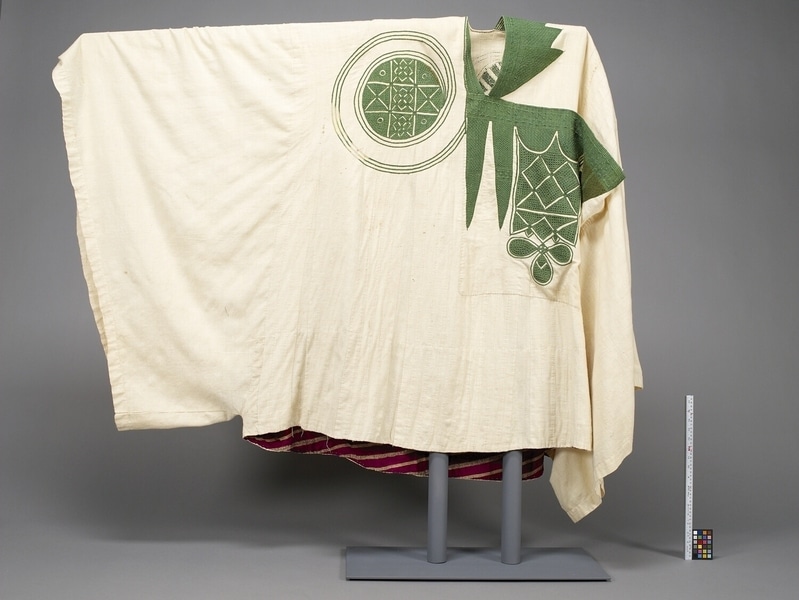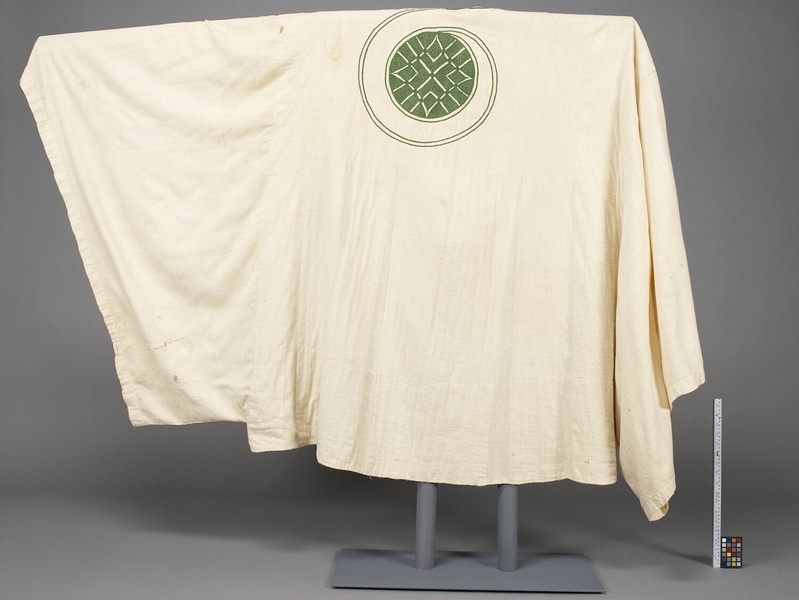Robe Item Number: Cb81 from the MOA: University of British Columbia


Description
Off-white robe with green embroidery and purple lining. The man’s robe is made of plain weave cotton cloth, with double strips sewn together to give desired width. The front and back panels are sewn together along shoulder line, leaving a right angled opening for the neck. The panels are also sewn at the bottom corners, narrowing the leg opening. The front of the robe is embroidered with two designs in green cotton. The first design is of two downward pointing needles of solid embroidery with a complex cartouche-shaped motif. The second design is a pair of spiral circles enclosing a complex rounded motif. The back of the robe is embroidered with only the pair of spiral circles enclosing a complex rounded motif. The inside lining is bias cut purple and gold striped cloth.
History Of Use
The baban riga (Hausa), agbádá (Yoruba), or boubou (French) is a large, loose-fitting, ankle-length robe worn by men of different groups in West Africa. The garment is said to have originated in the Middle East and introduced to West Africa by Arab and Berber merchants from the Maghreb and Tuareg through the trans-Saharan trade. Records show that this type of robe has been worn since the 11th century in ancient kingdoms across West Africa. The robe is usually worn at special events such as naming ceremonies and weddings. The attire was once considered a symbol of wealth and high-status due to its expensive fabrics and intricate embroidery.
Cultural Context
Worn by a man.
Iconographic Meaning
Design motifs featured on this robe are dagi knots and the two-pointed knife (aska biyu) pattern. The embroidery combines graphic elements common to the architecture and decorative arts of the Hausa. The quantity of cloth used makes a statement about the wealth of its owner, and the designs are meant to protect the person wearing the garment.
Specific Techniques
The Hausa baban riga would have been made by several men: from the braided motifs to the stitching of the cotton strips that create the fabric panel. The embroiders were called "malam" (scholars). Given the complexity of the embroidery, making this garment would have also taken several months. The source of the silk (sanyan or alapo-apo) was caterpillars found in the bush. They would cover themselves in cocoons of brown silk, which would then be collected, processed, and spun into thread.
Item History
- Made in Kano, Nigeria before 1910
- Collected during 1910
- Owned by Norman Lowden
- Owned by Yvonne Adams before August 3, 1976
- Received from Yvonne Adams (Donor) on August 3, 1976
What
- Name
- Robe
- Identification Number
- Cb81
- Type of Item
- robe
- Material
- dye and cotton fibre
- Manufacturing Technique
- woven, sewn, dyed and embroidered
- Overall
- height 248.5 cm, width 130.5 cm
Who
- Culture
- Hausa
- Previous Owner
- Norman Lowden and Yvonne Adams
- Received from
- Yvonne Adams (Donor)
Where
- Holding Institution
- MOA: University of British Columbia
- Made in
- Kano, Nigeria
When
- Creation Date
- before 1910
- Collection Date
- during 1910
- Ownership Date
- before August 3, 1976
- Acquisition Date
- on August 3, 1976
Other
- Item Classes
- textiles
- Condition
- good
- Accession Number
- 0321/0010